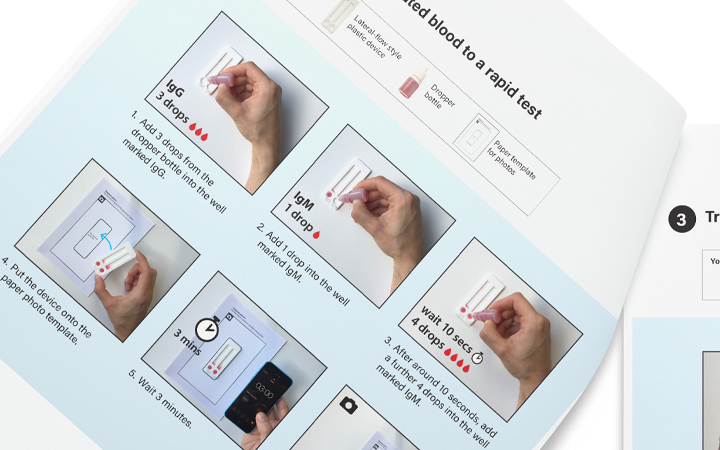We compared different formats of user instructions for Covid Antibody testing using lateral flow tests, and gathered information about how people use different formats of instructions.
What we produced
We produced three versions of instructions to explain procedural steps in carrying out a lateral flow test with fake blood. The versions of instructions varied in the technique used to represent the action steps: a static version with written text and illustrations, a static version with written text and photographs, and a video version with spoken text.
 Remote sessions were conducted with 8 volunteers to see what they thought of the instructions: 4 women and 4 men, between 49 and 80 years old. We asked them to read/view the three versions and to rate the versions according to perceived easiness to the test, clarity of the instructions, and their anticipated confidence in performing this test.
Remote sessions were conducted with 8 volunteers to see what they thought of the instructions: 4 women and 4 men, between 49 and 80 years old. We asked them to read/view the three versions and to rate the versions according to perceived easiness to the test, clarity of the instructions, and their anticipated confidence in performing this test.
Outcomes
Video instructions
- Good to provide a procedural overview. Participants liked the video version because it provided an accessible overview of the procedure.
- Not practical to follow while doing the test. Participants said they would need a print version that allows them to go at their own pace, and to review their progress.
Photographs or line drawings
- No clear preference for instructions with photographs or line drawings. Some participants thought that photographs were better at providing context, and that line illustrations enabled the depiction of detail more effectively.
Inclusivity and access
- Participants recognised that there may be preference for print instructions among older people, and that younger age groups may prefer online materials.
Difficult steps to carry out
Participants drew our attention to two procedural steps that were difficult to carry out:
- Dispensing liquid using the dropper bottle
- Collecting liquid using a pipette
This pilot study anticipates that both print and digital formats are needed, and that particular care is needed in relation to what are perceived as that challenging procedural steps.
This pilot study was conducted between November 2020 and January 2021.

